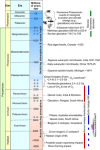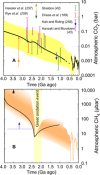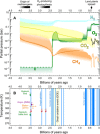The Archean atmosphere
- PMID: 32133393
- PMCID: PMC7043912
- DOI: 10.1126/sciadv.aax1420
The Archean atmosphere
Abstract
The atmosphere of the Archean eon-one-third of Earth's history-is important for understanding the evolution of our planet and Earth-like exoplanets. New geological proxies combined with models constrain atmospheric composition. They imply surface O2 levels <10-6 times present, N2 levels that were similar to today or possibly a few times lower, and CO2 and CH4 levels ranging ~10 to 2500 and 102 to 104 times modern amounts, respectively. The greenhouse gas concentrations were sufficient to offset a fainter Sun. Climate moderation by the carbon cycle suggests average surface temperatures between 0° and 40°C, consistent with occasional glaciations. Isotopic mass fractionation of atmospheric xenon through the Archean until atmospheric oxygenation is best explained by drag of xenon ions by hydrogen escaping rapidly into space. These data imply that substantial loss of hydrogen oxidized the Earth. Despite these advances, detailed understanding of the coevolving solid Earth, biosphere, and atmosphere remains elusive, however.
Copyright © 2020 The Authors, some rights reserved; exclusive licensee American Association for the Advancement of Science. No claim to original U.S. Government Works. Distributed under a Creative Commons Attribution License 4.0 (CC BY).
Figures





References
-
- Catling D. C., Glein C. R., Zahnle K. J., McKay C. P., Why O2 is required by complex life on habitable planets and the concept of planetary “oxygenation time”. Astrobiology 5, 415–438 (2005). - PubMed
-
- Cloud P. E., A working model of the primitive Earth. Am. J. Sci. 272, 537–548 (1972).
Publication types
LinkOut - more resources
Full Text Sources

